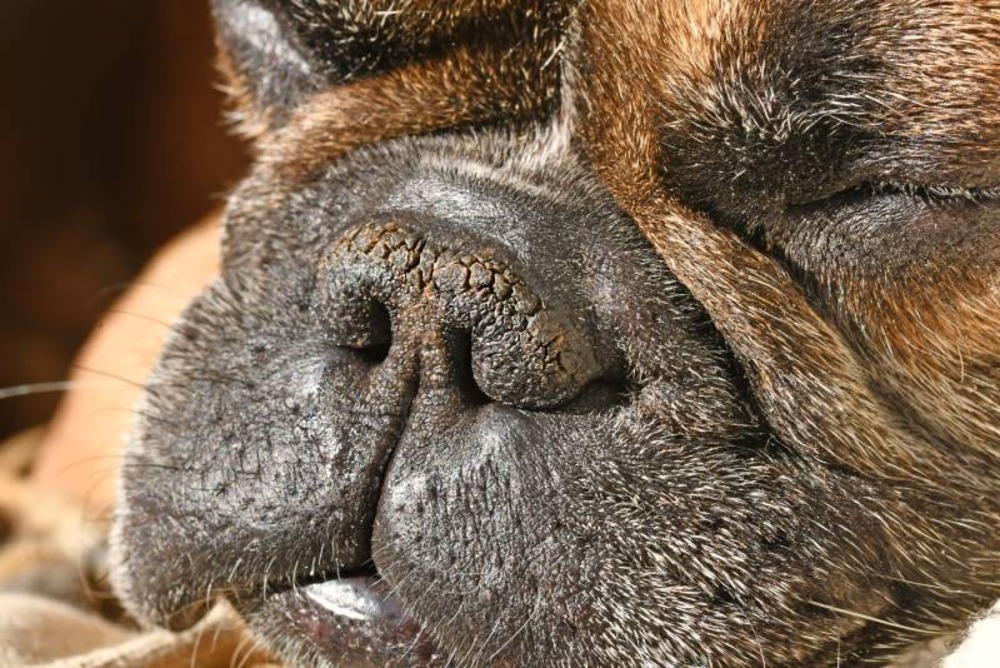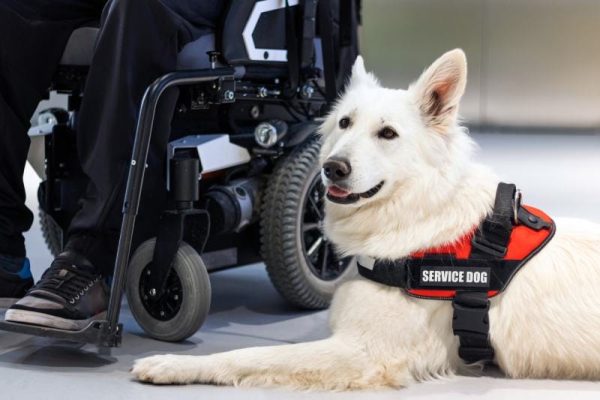If your dog usually has their nose in everything (including your face), you’ll likely notice if something seems different about it. There is plenty of information that describes what a “normal” dog nose should look like, but one factor everyone can agree on is that a chapped, sore nose is not normal.
Your dog’s nose could be chapped or dry for several reasons, some of which have simple solutions while others require more intensive treatment. In this article, we look at seven reasons why your dog’s nose might be chapped and how to fix the problem.

The 7 Possible Reasons for Your Dog’s Chapped Nose
1. Dehydration
Dehydration is one of the more serious reasons your dog’s nose could become dry and chapped. While dogs that have recently exercised might have a slightly drier nose for a short amount of time, if your dog has a dry nose along with other concerning signs they may be dehydrated. Signs to look out for include:

- Vomiting
- Loss of elasticity in the skin
- Panting
- Sunken eyes
- Lethargy
- Dry gums
If you notice these signs and think your dog is dehydrated, contact your veterinarian immediately. Keeping your dog hydrated and ensuring they always have access to clean, fresh water can prevent dehydration and nose chapping.
2. Sun or Wind Burn
In the summer months, sunburn can cause a dry, cracked nose. Dogs with lighter fur are more susceptible to sunburn than those with thicker coats. However, any dog can get sun damage to their nose, making the skin dry and cracked.
Windburn can also have the same effect, and high winds can dry out the delicate skin on the nose and cause chapping and cracks. Using dog-friendly sunscreen can prevent sunburn, and nose balm can prevent the wind and cold weather from drying out and damaging the skin.
3. Age
Dogs’ noses can change as they age, and older dogs can have drier noses. A long-term dry nose can cause chapping, so ensuring your pup has a moistened nose by applying nose balm can remedy the issue.
Because dogs lick their noses so often, the nose balm should be safe for them to ingest in small amounts.

4. Body Conformation and Breed
Some breeds are more prone to dry noses, which can lead to chapping. Brachycephalic dogs are more prone to having dry noses since they have more difficulty licking them to keep them moist. They are more prone to nasal hyperkeratosis, which also contributes to developing dry, crusty noses. Other conditions can also affect the nose, for example Lhasa Apsos are more prone to blocked tear ducts and this can cause the nose to become dry.
A nose balm and thorough cleaning of the nose and facial skin folds can prevent drying and infection around the nose, but if you’re concerned, you should take your dog to the vet.
5. Allergies
Allergies in dogs are common, and an estimated 10% to 20% of dogs in the US suffer from one form or another. Itchy skin, hair loss and recurrent ear and skin infections are more common signs of allergic skin disease, but some dogs may also suffer from a dry or sore nose. Mucocutaneous pyoderma, which is a bacterial infection which can affect the nose, can be secondary to underlying allergies. Affected dogs may suffer from redness, crusts and sores on their nose.
Talking to a vet is important if you think they may have allergies or an infection. Your vet may prescribe an allergy medication to help relieve the chapping and will treat any infections with topical or oral medications.
If you need to speak with a vet but can't get to one, head over to PangoVet. It's our online service where you can talk to a vet online and get the advice you need for your dog — all at an affordable price!

6. Health Conditions
Some health conditions, such as cancer, can affect your dog’s nose and cause chapping. Squamous cell carcinoma is a skin cancer that can affect a dog’s nose and cause dryness, chapping, and skin lesions. Sun exposure may contribute to the development of these tumors.
Skin conditions such as hyperkeratosis also cause chapped and cracking noses. Hyperkeratosis causes a buildup of keratin on the nose, leading to crusting and dryness, thickening, cracking, chapping and secondary infections. Your veterinarian can check your dog’s nose for any signs of these conditions, and the treatment will depend on which condition is causing the chapping.
Cancers can sometimes be excised or treated with radiotherapy. Hyperkeratosis can be softened with balms or creams, but more severely affected dogs may need to have some of the excess keratinised tissue removed.
7. Autoimmune Disease
Some autoimmune diseases can cause chapping, including discoid lupus erythematosus and pemphigus. Autoimmune disease occurs when your dog’s immune system attacks healthy cells in their body, your vet may recommend a biopsy to get an accurate diagnosis.
Discoid lupus erythematosus (DLE) causes crusting, scabbing, and chapping of the skin around the nose. Sometimes the nose will lose its normal bumpy appearance, and may lose pigment and change color. DLE can be managed with immunosuppressant medication, depending on how your dog responds to them.
If you’re concerned about your dog’s health we suggest you speak to a vet.
If you need to speak with a vet but can't get to one, head over to PangoVet. It's our online service where you can talk to a vet online and get the advice you need for your dog — all at an affordable price!

Are Dry Noses Normal for Dogs?
Although conflicting information surrounds whether a wet or dry nose is normal, dogs’ noses are usually slightly moist most of the time when they’re healthy. Overly wet noses or excessive discharge can indicate allergies, infection, or other health problems.
Equally, a very dry nose can be a sign of the health conditions mentioned above. Dogs need a slightly wet nose to work to their fullest capacity since a scent adheres to a wet (nose) surface better than a dry one. That means your dog’s incredible sense of smell is at its best, and a wet nose also keeps them cool!

Conclusion
Your dog’s nose is one of their most useful and prominent features. If you notice changes in their nose that concern you, a trip to the vet is necessary. Several causes of dryness and chapping can be easily remedied and prevented with a moisturizing nose balm, but some require veterinary treatment.
See also:
- How to Stop a Dog from Begging for Food: 7 Tips That Work
- Skijoring with Dogs: What It Is & How to Get Started with the Sport
Featured Image Credit: Firn, Shutterstock


















